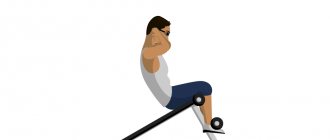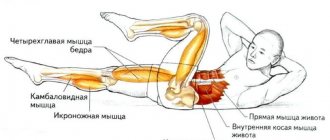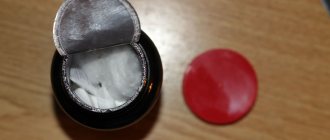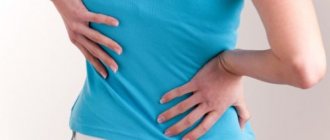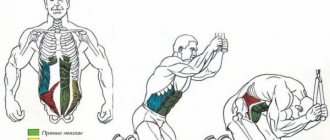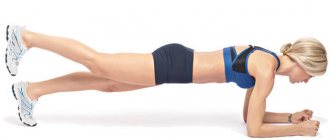Each of us at least once in our lives has been faced with the question: why is there a bloated belly? Sometimes this condition is accompanied by hardness of the peritoneum and painful sensations that make a comfortable existence impossible. And the rhythm of life of a modern person requires constant work.
No doctor will draw conclusions about what disease is developing inside the patient’s body based on just this single symptom; however, he will definitely send him for further examination. In this material we will try to figure out what a bloated belly signals and where to go for help.
Why a bloated belly?
Causes of bloating
If bloating appears an hour after eating, it is important to pay attention to the frequency of this symptom. If there has been overeating, a quick snack or consumption of a large amount of harmful foods, then the reasons for the discomfort are obvious. In cases where bloating appears constantly, it is necessary to visit a doctor and undergo an appropriate examination.
The following factors can cause severe bloating after eating:
- frequent consumption of foods that cause flatulence (sweets, cabbage, legumes, as well as other ingredients with a high content of coarse fiber and starch, the ability to be poorly digested and assimilated is also different from fatty foods);
- swallowing air when consuming food and liquid (excessive amounts of air can be caused by talking while eating, quick snacks combined with poor chewing of food, and drinking carbonated drinks while eating);
- the habit of eating on the go or talking while eating;
- drinking in large sips;
- smoking while eating;
- Abuse of fatty foods that require considerable time to digest. Fats create a feeling of fullness and heaviness in the stomach, causing bloating.
Diseases that may cause this article
If bloating occurs after eating, this may be a harbinger of existing gastrointestinal diseases:
- Bloating is observed in irritable bowel syndrome, in which motor function is impaired;
- Dysbacteriosis – a lack of bifidobacteria in the microflora, provokes the production of gases in the stomach after eating;
- Pancreatitis – failure of the pancreas (lack of enzymes);
- Celiac disease is a multifactorial disease, a digestive disorder caused by damage to the villi of the small intestine by certain foods containing certain proteins: gluten (gluten) and related cereal proteins (avenin, hordein, etc.) in cereals such as wheat, rye, barley.
- Helminthic infestations. Worms produce special substances that disrupt the functioning of the intestinal muscles. As a result, peristalsis slows down, food is retained and begins to rot. In addition, intestinal parasites, in some cases, can accumulate in a ball, which can cause a mechanical barrier in the path of moving food.
- Intestinal obstruction - the formation of tumors in the intestines.
Often, bloating after eating is associated with one of the above pathologies. Why is this happening? Due to the fact that the organs of the digestive tract are not able to timely and completely digest what they eat, food stagnates in the intestines.
After some time, it begins to wander and cause not only unpleasant sensations such as heaviness in the abdomen or swelling, but also symptoms such as constipation, severe gripping pain in the abdominal area, etc. In this case, therapy should be appropriate and timely.
Useful tips and rules for doing exercises to lose weight
Don't believe promises of quick weight loss. It will take more than a month to get the first results. It's easier to gain weight than to lose it later. There should be at least 2 hours between meals and training. Over the course of time, part of the energy will be absorbed, and the body will be replenished from reserves.
A weight loss workout should begin with a warm-up, such as jumping rope.
Any workout should begin with a warm-up. It is better to start it with a small cardio load, for example, jumping rope, light running. Afterwards, you need to knead all joints in a circular motion - from the neck to the ankle. Swings, circular movements, and bends are suitable for this. Each movement is repeated 10-15 times.
During the warm-up, the main thing is not to strain the muscles. Its task is to warm up the muscles and joints and prepare them for further work.
Don't miss the most popular article in the section: Laser hair removal on the face and body - how it is done, effectiveness, before and after photos, contraindications.
Types of flatulence
This clinical symptom is classified based on the causes that cause it:
- nutritional - associated with an incorrectly composed diet - abuse of fruits and vegetables, brown bread, soda and beer, as well as their incorrect combination with each other;
- dynamic - caused by a violation of the speed of intestinal contraction and slow digestion of food, most often occurs after surgical interventions on the digestive or genitourinary organs;
- digestive - its cause is disturbances in the digestive process (for example, the same hypolactasia and celiac disease);
- psychogenic - associated with mental disorders, including stress or shock;
- dysbiotic - develops due to changes in intestinal microflora, often occurs with gastritis, pancreatitis, cholelithiasis, etc.;
- high altitude - rarely diagnosed in patients, as it is associated with climbing to heights (for example, in the mountains). In this case, the cause of bloating is a decrease in atmospheric pressure.
Increased attention to the oblique abdominal muscles
If the exercises you perform are mainly aimed at the oblique abdominal muscles, then you should not be surprised that your waist will soon expand. Is this the effect you wanted to achieve?
Of course, the oblique abdominal muscles should also be trained, but only in a set of exercises with an even distribution of the load.
Symptoms
Bloating is difficult to confuse with something else. Fermentation of gases is felt in the intestine, a fairly loud rumbling is heard from there, and discomfort arises. All this is accompanied by a feeling of fullness. It should be noted right away that bloating can be very painful. For example, if during constipation gases accumulate in the intestines and stool becomes compacted, they cause stretching of the walls and pain that goes away after defecation.
If there is a large amount of gas, accompanied by abnormal stool, the patient may experience nausea, an unpleasant taste in the mouth, belching, and loss of appetite. But even if flatulence does not cause pain or other symptoms, but is simply accompanied by a loud rumbling, it creates a lot of inconvenience for a person.
It is necessary to urgently consult a specialist if flatulence is accompanied by the following phenomena:
- blood in stool;
- severe sharp pain in any part of the abdomen;
- temperature increase;
- nausea and vomiting.
With prolonged constipation, accompanied by bloating, symptoms of general intoxication of the body may be observed: headache and dizziness, general weakness, irritability, shortness of breath.
When the level of toxins in the body increases, the liver and pancreas begin to work harder, which can lead to the development of dysfunction of these organs.
How to choose an effective set of exercises to practice at home?
The choice of training program is influenced by many factors:
- weight;
- age;
- physical form;
- presence of chronic diseases;
- final goal;
- just organization.
When choosing exercises, it is worth selecting those that work the muscles of the problem area. But you should remember that the body burns excess reserves throughout the body and it is impossible to lose weight in one place. The workout should last 30 - 90 minutes. After 30 min. During intense exercise, the body begins to burn fat deposits.
You need to train 3-4 times a week.
In the complex, you should alternate exercises for different muscle groups so that they have time to recover after the load. Rest between sets should be 1 minute. You should choose classes that last several days. You can work on no more than 2 problem areas in one workout.
Example of a workout breakdown by day:
| Monday | Wednesday | Friday |
| Shoulder girdle, abs | Back, legs | Pectoral muscles, abs |
For young people who are slightly overweight, training will be enough to strengthen the whole body.
Diagnostics
In case of persistent flatulence, accompanied by pain of various types and not corrected by diet, you should consult a gastroenterologist or therapist. To find out the reasons, he will draw up a diagnostic action plan. It is possible that you will need to consult a neurologist, infectious disease specialist or oncologist.
At the first stage, a physical examination of the patient helps to obtain valuable information that will suggest the presence of a particular pathology. The patient's history and complaints, auscultation, percussion, and external examination of the abdomen with palpation are collected.
- Inspection. The contours of the abdomen during a visual examination will help determine the cause and nature of flatulence - general or local. For example, if the anterior wall of the abdomen is stretched in the shape of a dome, folds from intestinal loops are visible, then there is a high probability of intestinal obstruction. Noticeable wave-like contractions running from left to right, together with thickening in the epigastric region, suggest mechanical blockage of the gastric sphincter. Redness (erythema) of the palms is a characteristic sign of latent cirrhosis of the liver.
- Auscultation. Bowel obstruction is indicated by whistling noises or sloshing sounds made by accumulated fluid and/or gases. Bowel sounds may be increased (before the obstruction), weakened or completely absent.
- Percussion. When tapping the abdominal wall, a pronounced tympanic sound is heard. The accumulation of fluid in the abdominal cavity is manifested by a dull, fluctuating sound in the flanks of the abdomen. When the body position of the subject changes, the nature of the sound changes.
- Palpation. When gases accumulate in the small intestine, the tense wall of the peritoneum and individual intestinal loops are palpated. You can often feel the movement of gases under your fingers. Sometimes palpation helps to identify the presence of a tumor in the abdominal cavity.
The second stage consists of laboratory and instrumental diagnostics.
Laboratory research:
- Stool lipidogram. Prescribed for suspected neoplasms, other diseases of the pancreas, enteritis, etc. Helps identify disorders of lipid breakdown and absorption.
- General blood analysis. Leukocytosis, an increase in ESR are characteristic of inflammatory processes in the digestive tract, a decrease in hemoglobin, and erythrocytopenia are characteristic of anemia.
- Coprogram. It will help identify fermentopathy, digestive disorders, the presence of helminths, and lamblia.
- Stool culture for dysbacteriosis. To determine the ratio of beneficial, opportunistic and pathogenic bacteria.
- Feces for pancreatic elastase-1. Necessary for studying the condition of the pancreas, which produces this proteolytic enzyme involved in the breakdown of elastin.
- Feces for carbohydrates. To identify pancreatic pathology and inflammatory bowel diseases.
- Biochemical blood test. An increase in bilirubin is observed in hepatitis, amylase in pancreatitis, hypoalbuminemia in nonspecific ulcerative colitis.
Instrumental studies:
- Sigmoidoscopy with visual examination of the rectal mucosa.
- Colonoscopy involves examining the colon using a special probe inserted through the anus.
- X-ray of the intestine with contrast. Studying the passage of barium spreading through the small intestine helps to detect obstructions, diverticula, ulcerations and other intestinal pathologies.
- Irrigoscopy is an X-ray examination of the large intestine into which contrast is injected.
- Ultrasound of internal organs. To assess the condition of organs, detect a possible inflammatory process or tumor formations.
- Ultrasonography of the intestines - ultrasound examination of the intestines. Prescribed to identify tumors and free fluid.
How to treat and what to do if you have bloating after eating?
Abdominal bloating, accompanied by vomiting, acute abdominal pain, gas and stool retention, bleeding from the anus, a sharp drop in blood pressure, or loss of consciousness indicates a condition that doctors call “acute abdomen.” In this case, you need to immediately call an ambulance to hospitalize the patient in a hospital, where, most likely, the patient will undergo surgical intervention.
Physiological bloating does not require special treatment; to get rid of such a symptom, it is quite enough to change your diet. In other cases, the causes and treatment of bloating and food are two interrelated factors. Often, it is quite sufficient to use conservative therapy methods, namely:
- taking medications;
- maintaining a gentle diet;
- use of alternative medicine methods.
Clinicians prescribe the following groups of medications to their patients:
- Sorbents. These are drugs that absorb toxins and harmful substances, eliminate increased gas formation and bloating. Popular products are activated carbon, Enterosgel, Polysorb, Smecta. Medicines are taken according to instructions, activated carbon - at the rate of 1 tablet per 10 kg of weight.
- Drugs that eliminate flatulence (so-called defoamers). This list includes Espumisan, Infacol, Simikol, Simethicone, Mezim Forte. The active substances of the medications eliminate increased gas formation, facilitate the absorption of gases into the blood and their removal from the rectum.
- Herbal remedies with carminative effect. At the pharmacy you can buy “Carminative collection”, “Dill water”, tincture of fennel and caraway fruits, which reduce gas formation in the intestines.
- Antispasmodics. If bloating is accompanied by painful cramps, you can take antispasmodics (Mebeverine, Buscopan, Drotaverine, Papaverine). Enzyme preparations (Pancreatin, Creon, Festal) will help improve digestion and eliminate flatulence.
If the cause of bloating is dysbacteriosis, take probiotics (Linex, Bifidumbacterin, Bifiform). These products contain beneficial lactic acid bacteria, which will help restore beneficial microflora and normalize digestive processes.
The fight against flatulence with a gentle diet involves following several rules:
- complete rejection of fatty and spicy foods, as well as those foods that cause increased gas formation;
- preparing dishes using the most gentle methods. The main methods are boiling and steaming, stewing and baking without adding fat;
- eating food up to six times a day, but in small portions;
- eating meals every day at the same time;
- chewing foods thoroughly;
- consumption of food in a calm environment;
- control over the temperature of the food - it should not be excessively hot or extremely cold.
Good results can also be achieved by using traditional medicine, but before using them it is best to consult with your doctor. Non-traditional recipes include the use of:
- dill water;
- cumin and carrot seeds;
- fennel and cardamom;
- ginger and horseradish;
- coltsfoot;
- dandelion and plantain;
- St. John's wort and yarrow;
- bird cherry and cucumber;
- anise seeds and valerian root.
Surgical intervention is used when conservative medicine is unsuccessful, as well as for individual indications.
Diet and nutrition rules
When you have bloating, the first thing you need to do is review your diet, not only by correctly composing your diet, but also by following some principles.
Principles of nutrition during gas formation:
- Eliminate from your diet foods that increase the production of gases in the intestines. These products include all legumes, including lentils, soybeans, beans, beans, and peas. It is important to exclude all varieties of cabbage, since regardless of the type of preparation, they provoke active production of gases in the intestines. Various types of bread, especially yeast and whole grain breads, butter pastries, sweets, chocolate, dairy products, vegetable salads, eggplants, and sweet peppers also contribute to the appearance of flatulence. Some fruits and berries should also be excluded, such as grapes, bananas, apricots, plums, apples, pears.
- It is also necessary to reduce the amount of fatty foods and fried foods consumed. Fat helps slow down digestion, allowing food digested in the stomach and intestines to have much more time to ferment and produce gas.
- You should also reduce the number of foods that contain large amounts of fiber. Of course, fiber is useful and necessary for normal digestion, but at the same time it is also a fairly active gas-forming factor. Reducing or eliminating such foods should be temporary, and once the problem is resolved, fiber foods should be gradually added to the diet.
- You should not consume food “on the go”, since in a hurry it is impossible to fully chew food, and this significantly impairs digestion. You should eat food slowly, chewing each piece slowly and thoroughly.
- It is important to keep fit and stay in motion. You can take up some kind of sport or just take more walks. Walking after eating is very beneficial as it helps improve digestion.
Exercises for buttocks and thighs
Workouts for weight loss at home to work the buttocks and thighs should include squats. They are performed in two ways: feet shoulder-width apart or wider than shoulder-width apart. When performing the exercise in the first version, the back of the thighs is worked out, and in the second case, the inner part.
When doing squats, your knees should not go beyond your toes, and your hips should be lowered until they are parallel to the floor. Your back should remain straight during squats.
At the beginning, perform squats for 20-30 repetitions in one go, the set is repeated 3 times. After the exercise becomes easy, increase the number of repetitions.
Set of exercises:
- Slowly raise your leg while lying on your side. Lower. You can't throw your leg down! Perform 15-30 repetitions.
- Lying on your back, you need to lift your pelvis up, forming one line with the whole body. Focus on the shoulder blades and feet. Hold for a few seconds and lower. Repeat 15-30 times.
- You need to kneel down and place your hands on the floor. Raise your right leg up while simultaneously pulling your heel away from your body. Lower your leg to your knee. Repeat 10-30 times.
- Starting position as in exercise 3. You need to move your leg bent at the knee to the side. Do 20 swings, 3 sets on each leg.
- Stand with your back to the wall at a distance of 50 - 60 cm. Lower your pelvis down until your thighs are parallel to the floor. I use the wall as a support to hold the pose for a minute.
- Using a chair, bench or stair step can give you a good workout on your hips and buttocks. You need to take a step to the selected hill and go down. Do 10-15 times per approach.
Folk remedies
Folk remedies will also help with abdominal swelling:
- Parsley decoction – 20g. pour a glass of water, steam for half an hour, strain, drink a tablespoon at a time. up to 4-5 r.
- Dill water – 1 tbsp. Pour a glass of boiling water over the dried seeds, leave for a couple of hours, drink a quarter glass up to 2-3 r.
- Wormwood decoction – 1 tsp. pour a glass of boiling water, leave for half an hour, drink 1 tbsp. three times a day.
A good remedy that reduces gas formation in the intestines is a decoction of pumpkin seeds, tea with chamomile, St. John's wort or sage, a decoction of bird cherry fruits, leaves of coltsfoot or plantain. In order not to provoke unwanted complications, be sure to consult with your doctor before using traditional recipes.
Exercises for the abdomen and sides
At home, it is important to remember that using weights during training to reduce waist size will lead to the opposite result.
Effective exercises:
- Feet shoulder-width apart, knees slightly bent, abs tense. Smooth turn to the right, stay at the extreme point for 2-3 seconds. Make a left turn and pause. Perform 10 repetitions, 3 sets.
- While sitting on the floor, you need to rest your hands on the floor behind your back. Raise your legs. Hold it there for a few seconds. Gradually increase the exercise time.
- Lying on your side, bend your knees. Slightly twist the body to the right. Try to touch your heels with your hands. Hold the pose for a minute. Do 20 times on each side.
- Lying on your back, spread your arms out to the sides, palms pressed to the floor. Pull your knees towards your chest. Move your legs to the right without straightening your knees. Stay in this position for 1-2 seconds, return to the starting position. Do 20 times in each direction.
- Lying on your back, feet near your buttocks. Legs are bent at the knees. Move your arms to the right, legs to the left. The housing should twist in opposite directions. Move your arms and legs to the opposite side. Do 20 repetitions.
- On your back, hands under your lower back. Raise straight legs above the floor to 45 C. Lower them to a height of 5 cm from the floor. Repeat 10-20 times.
- Scissors. Lying on your back, raise your legs 45 C from the floor, bring them together and spread them without lowering them to the floor. Make 10-20 adducting and spreading movements.
| Press zone | Type of exercise | Number of repetitions | Number of approaches |
| Upper press | Raising the body from a lying position to a height of no higher than 20 cm from the floor. | At least 10 times | 3 |
| Medium abs | Lifting the body without lifting the feet from the floor to a vertical position | At least 15 times | 3 |
| Lower press | Raising your legs to different heights from the floor. | At least 10 times | 3 |
| Oblique muscles | Twisting the body diagonally. | At least 15 times | 3 |
Prevention
In order to prevent flatulence, you should maintain healthy sleep, proper nutrition, and not forgetting about an active lifestyle. If you have existing gastrointestinal diseases, you should not delay going to the doctor, hoping that the pathology will disappear on its own. Timely treatment will relieve severe forms of disease, improper digestion, and an increased amount of gases produced in the intestines.
It is necessary to eat food in fractional portions, chewing well. A good preventative method is periodic treatment with herbal enemas. If you often suffer from bloating, you need to stop eating cooked eggs; it is best to eat them raw. It is better to eat vegetables after steaming them.
If you have existing gastrointestinal diseases, you should not delay going to the doctor, hoping that the pathology will disappear on its own.
When the stomach swells, a feeling of heaviness arises, the mood disappears, and the desire for active pastime disappears. I want to lie down quickly so that the torment ends. There is no need to hide from the problem, the cause must be found and neutralized.
For accidental overeating, the medicine cabinet should contain drugs that speed up the digestion process (Mezim, Pancreatin), then there will be no discomfort from festive feasts.
The story of how they stitched up my torn abdominal muscles, and what a hernia of the linea alba is and what causes it... Well, and a review of the Elizabeth Hospital at the same time. Dedicated to mommies carrying babies in their arms.
How did I find out that my muscles were torn?.
Amelia and I
I'll start the story from the beginning. After my first birth, I was left with a very noticeable belly. About the fifth month. I wanted to buy a slimming corset and went into the store. Having chosen the one I liked, I asked the saleswoman if I could try it on. The saleswoman, looking at me indignantly, said: “Here, give birth and try it on!” “I’ve already given birth,” I squeaked and ran out of the store. My stomach remained with me for another six months and I got rid of it only thanks to daily three-hour swimming. In general, by the second birth I was determined to take care of my figure immediately after giving birth and get rid of the nasty belly as soon as possible. From about the third week of my baby’s life, I started going to the pool. It wasn’t light or dawn, she put the baby under her sleeping husband’s side and went for a swim. Three times a week I did water aerobics for 1 or 2 hours straight, then swam. And twice a week I went to the pool with my two-year-old daughter and swam with her, at the same time trying to do some exercises in the water. My weight quickly returned to normal, becoming even less than before my first birth - about 46 kilos. I lost a lot of weight, but... In the place where, according to my plans, beautiful abs should have appeared, there was some kind of unattractive bubble hanging. It looked like a sagging bag with something falling into it from below. I worked hard, but even when I pulled my stomach in for beautiful photos, the hanging butt remained. I thought that this was payback for two children and that it would probably get better over time.
Epiphany Periodically feeling my stomach (why is it hanging!), I once felt just above my navel... some kind of ball one and a half to two centimeters in diameter. With horror, continuing to feel, I found another one nearby! My mother came to visit and immediately sent me to the clinic to see a surgeon. My eyes, apparently, were so full of horror that they accepted me without a number and, it seems, without a queue.
In a matter-of-fact tone, the surgeon informed me that I had at least a couple of hernias and that my abdominal line was generally torn from top to bottom. What do you supposedly want: raising children? Are you carrying it? Do you carry it on your hands? Is it possible for a woman to carry weights of 10-15 kilos? In general, my warm greetings to all sling mothers who fanatically carry their children almost to school. I don’t understand at all how, with her husband walking next to her, a woman drags a very, very heavy child, and even in winter clothes weighing a couple of kilos, on herself. And a bag of children's things to boot. I especially don’t understand if it’s possible to take a stroller - you can also put heavy purchases there. At one time, we traveled a lot with the child to places where the stroller, in principle, could not pass, in Asia, for example, but in such cases the husband carried the baby carrier. Everyone, of course, has their own philosophy, but women who like to carry children on themselves must understand how this threatens to end. And then you won’t pick him up at all - you can’t. The doctor allowed me to lift the maximum loaf and gave me a referral to the Alexander Hospital.
And now a short “excursion into history.” For those who are only interested in my story, skip a few paragraphs. What is a hernia of the linea alba: In my words and from doctors’ explanations: The abdominal muscles are torn or separated. A hernia of the linea alba is a protrusion of organs anywhere along the midline of the abdomen, which runs from the chest to the pubis. Most often, this protrusion appears in the upper abdomen. That is, you see or can feel these balls. Especially when you strain yourself or lift something heavy. A hernia of the linea alba may be accompanied by pain in the upper abdomen, especially with abdominal tension and sudden movements. But nothing hurt me. The hernia may not be noticed at all.
What causes abdominal muscles to tear and a hernia of the linea alba appears:
- Excessive physical activity or lifting heavy objects even once
- Multiple pregnancies, labor without recovery, or difficult labor. During pregnancy, the load on the abdominal wall muscles increases, which is why a hernial protrusion develops, and during labor, the situation may worsen.
- Diseases of the respiratory system accompanied by chronic cough
- Rarely - hereditary predisposition
- Chronic constipation, which is accompanied by regular straining
- The cause of the hernia is weakness of the connective tissue, as a result of which a gap is formed between the left and right rectus abdominis muscles. Through this gap, first the fat emerges under the skin, and then the abdominal organs. The distance between the muscles can reach 10 centimeters!
Is it possible to cure a hernia of the white line without surgery? NO! A hernia of the linea alba must be operated on. Neither as a result of gymnastics, nor under the influence of drugs or bandages, the hernia will not disappear.
Well, now let's get back to me. Looking for a doctor Having received a referral from the surgeon at the clinic, I went to the Alexander Hospital. A respectable doctor confirmed the diagnosis, was a little upset when he learned that I was in the direction of the pole, and began to “process” me. From the area “there is good anesthesia, but it is paid, and there is free, but who knows... the anesthesiologist has to pay for it. There are beautiful seams, and then there are…” Well, you understand. At the same time, imagine my condition - I was in the hospital at the age of 5, and then only in the maternity hospital. And I’ve never broken anything in my life except a nail... And here - “You’re walking around with torn muscles and at any moment an internal organ can be pinched there and that’s it... crap!” It's very funny to hear that. I burst into tears in the doctor’s office and said that I would come to him later. Moreover, he said that I needed to do only two operations and install a mesh (why it is impossible to cut out hernias, sew up the muscles and install a mesh in one go, I still don’t understand) and I had to prepare for this mentally. By the way, the doctor assured me that with the mesh I could easily continue to give birth...
Elizabeth Hospital After searching the Internet, I found out that hernias and ruptures cannot be treated without surgery. A couple of months later (we were busy moving) I was still alive and even gave up on the fact that I couldn’t carry heavy things. After all, children... In general, I actively painted the ceiling, hung wallpaper, and had a lot of fun. Then I remembered that I had a surgeon friend, albeit from a different area. I asked him to recommend someone and he gave me the phone number of the doctor in Elizavetinskaya who cut out his appendix.
My doctor is in the middle
Having agreed with the doctor, I arrived at the hospital.
I had to wait an hour and a half for the doctor, during which time I looked at photographs of doctors on the walls. The doctor’s voice was very young, and by process of elimination I chose from a photo on the wall a young, serious doctor who inspired confidence. “Exactly him,” I thought. Then a very young guy approached me, who looked about 25 years old and... it turned out that this was my doctor! Of course, I was very surprised. It was reassuring that he said that he also has two children. Maybe he just looks so young? The doctor was attentive, prescribed an operation, and said that the mesh should not be installed under any circumstances if I plan to give birth again. The only sad thing is that with subsequent pregnancies the situation may well repeat itself... And not a word about money. Not even the slightest hint! This really captivated me - the man does his job honestly. I thought for a long time whether to decide to have surgery. If we compare everything that I heard from the two doctors, it seemed as if they were talking about two different operations. And this mesh... The surgeon I knew also didn’t say anything decisive - they say, trust whoever you want. For me, the decisive phrase was a friend’s phrase “well, I entrusted myself to him.” In addition, I thought that the young doctor would perform the operation more diligently, and perhaps his knowledge would be more recent, although he would have less experience.
Having made up my mind, I began collecting tests. Somehow everything worked out quickly, they immediately gave me a coupon for an ultrasound scan, did a fluid test, visited all the doctors, donated half a liter of blood...
Admission to the hospital I arrived at the Elizabeth Hospital at 9, went up to the 8th floor to the surgical department. An impressive crowd had already gathered in front of me. Everyone was required to sign the manager on the referral. The manager, having signed, sent me to the same place as the others - to the 1st floor. Considering that I had all my things with me, including a heavy laptop and a jacket, it was not fun. Well, it’s necessary, it’s necessary. An endless, endless corridor awaited me below.
Finally, the required office was found and the autograph of another uncle was received. I went up to the 8th floor to the reception area. And then I was glad that I still needed to fill out a medical history. Yeah, on the first one! I mentally swore why they didn’t tell me earlier, they mentally answered with a look that I didn’t ask myself) I threw all my things on the floor behind my sister’s post and went to the first one. Considering that the regular elevator was broken and everyone was being transported on a freight elevator, inside of which there was a pregnant woman - one of the hospital workers, and who was not very happy about transporting everyone, so she went on foot. I learned from the signs that there is a pharmacy at 7. It might come in handy.
At the first one, in front of the office I needed, a familiar company was already sitting. Almost immediately it was my turn. But when I came out, there was already a crowd of about 20 people standing. I was lucky. I moved up to eighth again. The corridor was decorated with droppers, like lanterns on an avenue.
Then we were all informed that there were no places and we had to wait until someone was discharged. By the way, the nurses at the post are wonderful, smiling and polite. I sat down at the dressing station. People flocked there and after the first comrade with tubes sticking out of his stomach and with a bag into which some kind of bloody liquid was dripping, I realized that I could not cope with the lump stuck in my throat and ran away to the end of the corridor. Then I went to the dining room for tea with a thermos mug, found an outlet and realized that I was no longer afraid of the wait. Although sitting on an iron chair for up to 13-14 hours is, of course, not a very pleasant procedure, even with a laptop on your lap.
Nearby they discussed that all the rooms were for six... And the nurse asked who wanted to go to the paid room for two. Looking into one of the six-bed rooms, I realized that I was broken, that I needed to love myself and in general... And I went to a paid ward. The cost, of course, is the same as a two- or three-star hotel in Europe, but I will perceive spending time in the hospital as a vacation. I'll work in silence, after all.
This is what a paid ward looks like in the Elizabeth Hospital . I was pleased with the bed with a comfortable table for a laptop. The table extends and rotates in all directions, I want one for my home)
There is even something like a TV and a refrigerator. True, I don’t watch TV on principle, but I turned on the refrigerator. And she turned it off after five minutes - it hummed like an electric locomotive on the road. The cost of a double room in the Elizavetinskaya Hospital is 1,400 rubles per day, a single room is 1,900 rubles per day
Then the anesthesiologist came to see me. Charming woman. She explained, of course, that anesthesia can be good or so-so. Like sausages for 50 re and 300, but I had already decided that regular anesthesia would be enough for me. The anesthesiologist is really very nice.
They brought a neighbor who had undergone surgery. They told me to wake him up periodically just in case. The staff came to check on us about every 20 minutes.
Then my doctor came in with another one. Like, the second doctor will assist in the operation. The second doctor looked even younger and the thought even crept into my mind - maybe an intern? But the sign didn't seem to say that. I was scheduled for surgery the next day. At first it was scary - very young doctors. Then it kind of didn’t matter. The doctor promised a beautiful stitch and a repeat operation after the next birth...
Food at the Elizabeth Hospital At lunchtime, a funny line of robes and sweatpants formed outside the dining room, rattling their plates and spoons. There was a strong smell of fish coming from the dining room. But they poured borscht... It turned out that everyone’s food is different, just like in a restaurant. New arrivals are only offered soup... And for some reason, fish soup. Granny, on the contrary, said that she would never eat something like that, but I liked it. I was tormented by the thought that my next meal would only be in one and a half to two days. Everything would probably seem delicious to me now. However, when they started serving corn porridge without salt and sugar for dinner, I was even glad about my diet. Why someone was given a casserole at the same time, I don’t know...
In general, at the sight of people who had tubes with bloody liquid sticking out of their sides or belly, pouring into bags that they carried with them, somehow there was no appetite left.
In the morning I donated blood, was told to shave, stay in a T-shirt, and was taken on a gurney to the operating room. Lying down, it seemed as if the gurney was being carried by a meteor. The last thing I remember is an anesthesiologist inserting a needle into a vein, and young doctors pointing flashlights at my stomach. “Make a beautiful seam,” I managed to squeak and disappeared, plunging into some kind of cold. I have no more memories of this day in my life. The neighbor says that afterwards I was pounding and all the available blankets were taken down on me. And that she talked to me all the time. Mom says she came. I’m like the little bear in the cartoon “The Winter’s Tale”: “I don’t remember, I don’t remember any of this”! I woke up the next day, learned to roll over and stand up. I found a needle in my hand.
I even had breakfast.
In the afternoon I went to get a dressing done - the camera fell out of my pocket - since it was caught, collected and given to me - I couldn’t resist taking a photo.
Here's dinner. I begged for a casserole. Mom brought cheese. But I didn’t want to eat.
In the afternoon, the neighbor was discharged and a granny was taken in, who snored like three tractors in a swamp combined. My temperature rose to 38. They gave me an injection. I did not sleep all night.
For morning breakfast I asked for an omelette to go with the porridge. The omelette I was not supposed to have turned out to be unsalted. Here is the sadness of unexpected joy, gently poured into porridge...
Bandaging again. The doctor, with the words “Well, let’s see why you have a fever,” took a long metal pin and intended to pierce my seam. Before he could touch me, I was already squealing that it hurt. The nurse laughed that if it hurt, I would cry. I tried to cry, but it didn’t work. The doctor poked around in my stitch, but didn’t seem to find anything. It wasn't pleasant. His stomach resembled a chewed rag. But it turns out that I can only study after six months... I can’t stand it.
But after the dressing it became a little painful. However, I was already accustomed to walking along the corridors with the gait of a drunk - with my back bent like a question mark and my legs moving out wide. I was prescribed antibiotics for my fever.
They brought a neighbor. Normal people pass out after anesthesia and cannot come to their senses, but this one talked non-stop, tried to get up, asked to put socks on her, then give her her jaw, phone... And she kept saying something. It seems that the anesthesia was not enough for her - she was eager to fight and was indignant at why the walls were crooked. Paid chamber, her mother.
I went to the doctor but they didn’t let me go home. In general, I’ll finish my story here for now, and when something interesting happens, I’ll add it. I’m sitting, waiting for lunch while my neighbor snores) I’m trying to demand that they let me out... Well, I want to go home to the children)
And some more useful information: What to take for hospitalization at the Elizabeth Hospital (From the experience of visiting the third surgical department) Shoe covers Slippers Clothes (tracksuit, robe, whatever is comfortable), a change Jacket - it’s cold in the corridor. But it's hot in the room. A cup, spoons, forks, a plate (If they don’t have them, then they will give you something. But everyone brings their own) A charger for the phone, something to do - magazines, a laptop - there’s nothing to do there. Soap-paste-brush-towel-comb-toilet paper. Earflaps (hello to your roommates) Wet wipes for yourself and to wipe all sorts of bedside tables Sugar, tea, coffee if you are stuck for a long time, you can put food in the refrigerator in the hallway
Passport-policy-referral-tests - and so it’s clear.
If anything, there are stalls downstairs where you can buy food and water (exorbitantly expensive). There are all sorts of slippers, T-shirts, nighties, and newspapers too. And two pharmacies. There is also some kind of canteen there.
What to take to the operation and after: You will go to the operation in your T-shirt nightie. Take a longer one - panties are not intended for surgery. Socks Water in a sippy bottle; do not eat for a day after surgery, but you can drink while lying down. Bandage if needed.
Well, and most importantly - the final review of the Elizabeth Hospital: Wonderful nurses, barmaids, doctors - I didn’t hear a single rude word, no rudeness!!! They took blood - without even having time to groan, very professionally. Yes, there are not enough places and someone is lying in the corridor - but what can you do here, there are a lot of people. The food, for my taste (I’m used to wholesome and healthy food), is very tasty, even the porridge is too sweet. If you ask, they will give you all the pills and give you a painkiller injection. You can ask the nanny for a little gratitude to go downstairs and buy water or whatever you need if you can’t do it yourself. No hints of bribes, gratitude, etc. - pleasantly pleased! They worry about the sick, check on them all the time, that is, not just a “duty” attitude. In general, I thank the staff of the third surgical department of the Elizabeth Hospital!
UPDATE: Here are photos of my belly after 9 months!!!
My best portrait!
By

